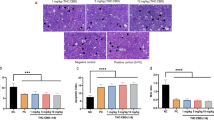Abstract
Cannabis sativa has long been used as a traditional medicine in China. Among its effective compounds are cannabinoids. This study determined the effect of WIN55,212-2 (WIN), a synthetic cannabinoid, on the BEL-7402 human hepatocellular carcinoma (HCC) cell line. The results showed that WIN could decrease the proliferation of BEL-7402 cells. Moreover, WIN could cause apoptosis of the cells via up-regulation of Bax expression, down-regulation of Bcl-2 expression, induction of the mitochondrial membrane potential, increase of caspase-3, -8 and -9 activities, and induction of the cleavage of caspase-3 and poly-ADP-ribose polymerase (PARP). The WIN-induced apoptosis was accompanied by the up-regulation of PPARγ expression, the activation of PPARγ DNA binding activity, and a down-regulation of PPARγ target oncogene c-myc. Conversely, the effects of WIN could be attenuated by PPARγ antagonist GW9662, and the WIN induced PPARγ expression was partially attenuated by AM630, a cannabinoid receptor-2 antagonist, whereas the WIN-induced reduction of c-myc expression was partially restored by GW9662. Collectively, our results suggest that WIN can decrease the proliferation and cause apoptosis of the BEL-7402 cells via a mitochondrial-caspase pathway and mediated by PPARγ. These results may provide a basis for the application of WIN in HCC treatment.









Similar content being viewed by others
References
Lin H, van den EJ, Liu C, van Gulik TM (2011) Systematic review of hepatocellular adenoma in China and other regions. J Gastroenterol Hepatol 26:28–35
Tanaka M, Katayama F, Kato H, Tanaka H, Wang J, Qiao YL, Inoue M (2011) Hepatitis B and C virus infection and hepatocellular carcinoma in China: a review of epidemiology and control measures. J Epidemiol 21:401–416
Hermanson DJ, Marnett LJ (2011) Cannabinoids, endocannabinoids, and cancer. Cancer Metastasis Rev 30:599–612
Bowles DW, O’Bryant CL, Camidge DR, Jimeno A (2012) The intersection between cannabis and cancer in the United States. Crit Rev Oncol Hematol 83:1–10
Calvaruso G, Pellerito O, Notaro A, Giuliano M (2012) Cannabinoid-associated cell death mechanisms in tumor models (review). Int J Oncol 41:407–413
Giuliano M, Pellerito O, Portanova P, Calvaruso G, Santulli A, De BA, Vento R, Tesoriere G (2009) Apoptosis induced in HepG2 cells by the synthetic cannabinoid WIN: involvement of the transcription factor PPARgamma. Biochimie 91:457–465
Wang Y, Zhou YT, Zhao Q (2010) The effect of the activation of cannabinoid receptor on the proliferation and apoptosis of hepatoma HepG2 cells. Xi Bao Yu Fen Zi Mian Yi Xue Za Zhi 26:344–347
Schulman IG, Shao G, Heyman RA (1998) Transactivation by retinoid X receptor-peroxisome proliferator-activated receptor gamma (PPARgamma) heterodimers: intermolecular synergy requires only the PPARgamma hormone-dependent activation function. Mol Cell Biol 18:3483–3494
Pertwee RG (2010) Receptors and channels targeted by synthetic cannabinoid receptor agonists and antagonists. Curr Med Chem 17:1360–1381
Pertwee RG (2005) Pharmacological actions of cannabinoids. Handb Exp Pharmacol 168:1–51
Kumar RN, Chambers WA, Pertwee RG (2001) Pharmacological actions and therapeutic uses of cannabis and cannabinoids. Anaesthesia 56:1059–1068
van der SM, Di M, V (2005) Cannabinoid receptors and their role in neuroprotection. Neuromolecular Med 7: 37–50
Dainese E, Oddi S, Bari M, Maccarrone M (2007) Modulation of the endocannabinoid system by lipid rafts. Curr Med Chem 14:2702–2715
Xu X, Liu Y, Huang S, Liu G, Xie C, Zhou J, Fan W, Li Q, Wang Q, Zhong D, Miao X (2006) Overexpression of cannabinoid receptors CB1 and CB2 correlates with improved prognosis of patients with hepatocellular carcinoma. Cancer Genet Cytogenet 171:31–38
Rosen ED, Spiegelman BM (2001) PPARgamma : a nuclear regulator of metabolism, differentiation, and cell growth. J Biol Chem 276:37731–37734
Acknowledgments
We want to thank Fred Bogott, M.D., Ph.D., at Austin Medical Center, Austin, Minnesota, for his excellent English editing of this manuscript. This work was supported by the National Science Foundation of China [81141101] and the Scientific and Technological Project of Guangzhou City [No. 2009J1-C361].
Author information
Authors and Affiliations
Corresponding author
Rights and permissions
About this article
Cite this article
Hong, Y., Zhou, Y., Wang, Y. et al. PPARγ mediates the effects of WIN55,212-2, an synthetic cannabinoid, on the proliferation and apoptosis of the BEL-7402 hepatocarcinoma cells. Mol Biol Rep 40, 6287–6293 (2013). https://doi.org/10.1007/s11033-013-2741-x
Received:
Accepted:
Published:
Issue Date:
DOI: https://doi.org/10.1007/s11033-013-2741-x




